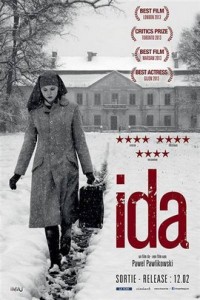Ida is a film about the connection between two characters who are related; one has lost faith, and another drawn closer to her faith.
The story opens with a convent in Poland where Anna has been raised and is approaching the period for taking her vows. She is summoned by the Mother Superior and strongly urged to meet for the first time her aunt Wanda, as she represents the only surviving member of her family. Anna reluctantly agrees to visit her aunt, and upon arrival at her aunt’s apartment learns she was born to a Jewish couple that perished in the Holocaust. Curious about her parents, Wanda suggests they journey to the town of her birth to locate their family’s graves.
Wanda’s experience as prosecutor and judge are reflected in her questioning of the family that took possession and inhabits her parents’ farmhouse. Through guilt and shame, she is able to exact a concession of the location where her family’s bodies have been interred. During this process, Wanda reveals to Anna she left behind her young son in the care of these neighbors to hide him from the Nazis while Wanda joined the Resistance movement to fight.
Wanda and Anna’s journey serves two purposes; to understand the pain Wanda’s trying to mask and foster a sense of empathy about why she drinks, as well as an opportunity for Wanda to challenge Anna’s resolute devotion to religion and her commitment to abstaining from something she has never experienced, and in so doing, Wanda is in essence trying to question her faith.
Filming Ida in black and white was a smart choice. The interior scenes are shot in high contrast reminiscent of a style used in film noire, and many of the exterior scenes in snow and overcast skies are washed out long shots that create a silhouette effect, which compliments the mood and feel of the film. The nuns positioned at the very bottom of the frame in one of the opening scenes inside the convent’s dining hall creates an appearance similar to a Dutch masters painting. It serves as an example of Pawel Pawlikowski’s artistry.
Ida is sparing in its use of dialogue and combines interesting visuals to make a wonderful film that is well worth seeing.

